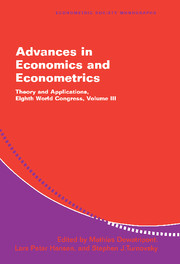Book contents
- Frontmatter
- Contents
- List of Contributors
- Preface
- 1 Contracting Constraints, Credit Markets, and Economic Development
- 2 Factor Models in Large Cross Sections of Time Series
- 3 Macroeconomic Forecasting Using Many Predictors
- “Big Data” Dynamic Factor Models for Macroeconomic Measurement and Forecasting: A Discussion of the Papers by Lucrezia Reichlin and by Mark W. Watson
- 4 How Severe Is the Time-Inconsistency Problem in Monetary Policy?
- 5 New Perspectives on Monetary Policy, Inflation, and the Business Cycle
- Comments on Papers by Stefania Albanesi, V. V. Chari, and Lawrence J. Christiano and by Jordi Galí
- 6 Consumption Smoothing and Extended Families
- 7 Computational Methods for Dynamic Equilibria with Heterogeneous Agents
- Index
4 - How Severe Is the Time-Inconsistency Problem in Monetary Policy?
Published online by Cambridge University Press: 06 January 2010
- Frontmatter
- Contents
- List of Contributors
- Preface
- 1 Contracting Constraints, Credit Markets, and Economic Development
- 2 Factor Models in Large Cross Sections of Time Series
- 3 Macroeconomic Forecasting Using Many Predictors
- “Big Data” Dynamic Factor Models for Macroeconomic Measurement and Forecasting: A Discussion of the Papers by Lucrezia Reichlin and by Mark W. Watson
- 4 How Severe Is the Time-Inconsistency Problem in Monetary Policy?
- 5 New Perspectives on Monetary Policy, Inflation, and the Business Cycle
- Comments on Papers by Stefania Albanesi, V. V. Chari, and Lawrence J. Christiano and by Jordi Galí
- 6 Consumption Smoothing and Extended Families
- 7 Computational Methods for Dynamic Equilibria with Heterogeneous Agents
- Index
Summary
INTRODUCTION
The history of inflation in the United States and other countries has occasionally been quite bad. Are the bad experiences the consequence of policy errors? Or does the problem lie with the nature of monetary institutions? The second possibility has beene xplored ina long literature, which starts at least with Kydland and Prescott (1977) and Barro and Gordon (1983). This paper seeks to make a contribution to that literature.
The Kydland–Prescott and Barro–Gordon literature focuses on the extent to which monetary institutions allow policymakers to commit to future policies. A key result is that if policymakers cannot commit to future policies, inflation rates are higher than if they can commit. That is, there is a time-inconsistency problem that introduces a systematic inflation bias. This paper investigates the magnitude of the inflation bias in two standard general equilibrium models. One is the cash–credit good model of Lucas and Stokey (1983). The other is the limited-participation model of money described in Christiano, Eichenbaum, and Evans (1997). We find that, for a large range of parameter values, there is no inflation bias.
In the Kydland–Prescott and Barro–Gordon literature, equilibrium inflationin the absence of commitment is the outcome of anin terplay between the benefits and costs of inflation. For the most part, this literature consists of reduced-form models. Our general equilibrium models in corporate the kinds of benefits and costs that seem to motivate the reduced-form specifications. To understand these benefits and costs, we must first explain why money is not neutral inour models.
- Type
- Chapter
- Information
- Advances in Economics and EconometricsTheory and Applications, Eighth World Congress, pp. 123 - 150Publisher: Cambridge University PressPrint publication year: 2003



